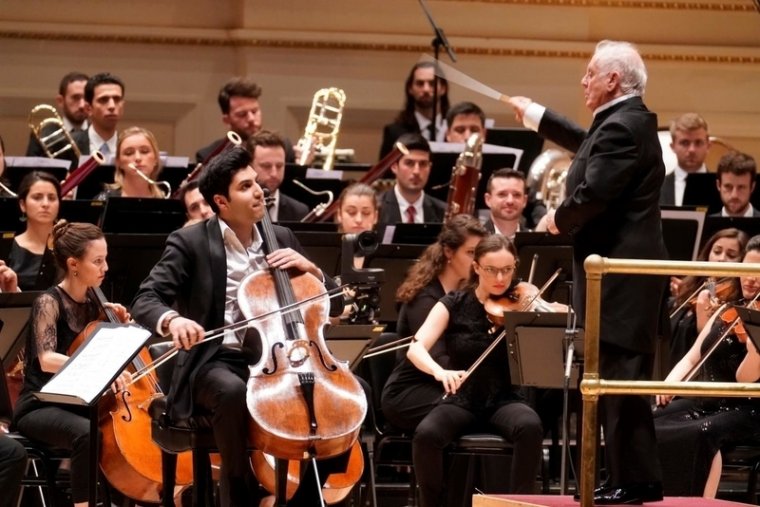Barenboim, West-Eastern Divan Orchestra bring idealism, chops to Carnegie Hall

Kian Soltani was soloist in Strauss’s “Don Quixote” with Daniel Barenboim and the West-Eastern Divan Orchestra Thursday night at Carnegie Hall. Photo: Chris Lee
A sense of public service suffused Thursday’s concert at Carnegie Hall by the West-Eastern Divan Orchestra, conducted by Daniel Barenboim. The event was billed not only as a benefit gala for the orchestra, which was founded nearly 20 years ago to foster international understanding in the Middle East, but as the Isaac Stern Annual Memorial Concert, honoring the violinist who led the movement to save Carnegie Hall from demolition in the 1960s.
Of course, noble efforts sometimes prove “quixotic,” as the program’s opening piece, Richard Strauss’s droll musical fantasy Don Quixote, wryly demonstrated. Such thoughts were presumably far from the minds of Barenboim and his young players of Israeli and Arabic nationality, as they gave a lucid, spirited performance of the familiar work.
Dramatic values shared the spotlight with musical ones, as each of the episodes in the old knight’s checkered career leaped vividly to the mind’s eye, while the orchestra’s crisp ensemble and deft handling of the intertwining themes showed Strauss’s composing skills to excellent advantage.
For his part, cello soloist Kian Soltani—the orchestra’s principal cellist, as Strauss intended, not a jet-lagged celebrity from afar—seemed to inhabit the role of the dotty Don not just with bow and fingers, but with an actor’s imagination. His fierce glance stage left as the orchestra announced the approach of “robbers and villains” (actually peaceable pilgrims) was priceless.
Seated not in the orchestra but on a platform next to the podium—a concession to the size of the hall and Strauss’s robust scoring—Soltani commanded attention with hard-charging runs in the knight’s battles and caramel-toned reflection in the vigil and death scenes. (He also treated the audience to an encore, a delicate, somewhat up-tempo rendition of “The Swan” by Saint-Saëns.)
From her chair in the orchestra, violist Miriam Manasherov was all easy charm in her dialogues with the Don as Sancho Panza, a believable Everyman rather than a rustic caricature.
In fact, avoidance of exaggeration and effect characterized the entire performance. The notorious muted brass as bleating sheep were just part of the scene in Variation II, not the whole show. Strauss’s introduction of the wind machine to the symphony orchestra was treated not as a landmark in music history, but as a nice whooshy color for the Don’s and Sancho’s sky ride.
Instead of lingering on such matters, conductor Barenboim kept the music moving forward, shaping it in the air with bold gestures, at age 76 seeming to transmit energy to his twenty-something players rather than the other way around.
The same big-picture approach greatly benefited the first movement of Tchaikovsky’s Symphony No. 5 in E minor, which can sound episodic, a tiresome string of crescendos. But Thursday’s performance rolled out in sweeping periods, developing a fateful momentum to rival another famous Fifth, Beethoven’s.
Likewise, the horn player (not identified in the program) didn’t dawdle over the celebrated theme of the Andante cantabile, but phrased it tenderly nevertheless. Taking seriously for once the composer’s indication “con alcuna licenza” (with no license), Barenboim kept the forward motion going, while not neglecting the expressive effect of the music’s striking key changes. And moments such as the return of the first theme in muted violins with oboe obbligato got their due, exquisitely prepared, tuned and balanced.
Moving ever forward, the conductor barely paused at all between the symphony’s last three movements. It’s possible he could have used a breather himself, since during the waltz-scherzo and the finale his left hand was often busy not conducting but pulling a handkerchief from his pocket and mopping his brow. The orchestra’s rhythmic lift and tight ensemble seemed to slack off a little, just when needed to make the waltz sparkle, the trio scamper, and the motto theme summon listeners to the final party.
But as the finale went on, the players found their footing again, and the long coda roared ahead to its triumphant conclusion. If only, one thought, life in the Middle East could follow such a darkness-to-joy scenario.
An encore, “Nimrod” from Elgar’s “Enigma” Variations, seemed to capture in its noble swell the hope behind this multinational orchestral enterprise.
Another favorite Barenboim cause, the rehabilitation of Wagner’s music in Israel, got its due in the second encore, the Overture to Die Meistersinger. One found that it was possible to admire the conductor’s mission while also feeling that, following the Tchaikovsky and Elgar, Wagner’s anthem sounded a bit crass and jingoistic.
Orpheus Chamber Orchestra performs works of Bach, Waxman, Wallfisch, Rota and Rósza at Carnegie Hall, 8 p.m. Saturday. carnegiehall.org; 212-247-7800.